I’ll get to the point straight away: Rome is an amazing city in every regard, from some of the most delicious Italian food found in many of the trattorias, to the rapid segue from stunning architecture to ancient Roman ruins as you walk around the city. I spent six days in Rome, however I think I could spend a lifetime there.
Six days isn’t nearly enough to sample all of the food offerings, however here is a list of some of my favourites.
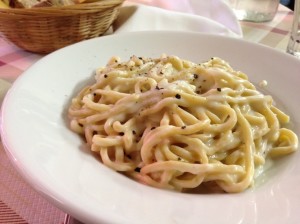 Cacio e Pepe at Da Enzo al 29 in Trastevere |
Cacio e Pepe There are a few pasta dishes that are found consistently on the menu of just about trattoria in Rome, one of which is spaghetti cacio e pepe, which literally means cheese and pepper. It is pretty much the Roman answer to Kraft’s Mac n’ Cheese, and an answer that is far far superior. Traditionally cacio e pepe uses lots of Pecorino Romano cheese (a sheep milk cheese produced in parts of Lazio), which is quite salty and has a bit of kick. Don’t go to Rome without trying a plate of cacio e pepe! |
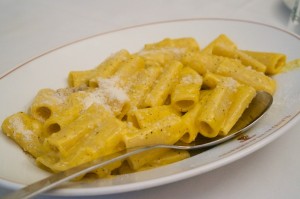 Rigatoni carbonara at Flavio al Velavevodetto in Testaccio. Notice how the pasta is not drowning in cream. |
Pasta Carbonara Next on the list of must-eat pasta dishes is something a little more well known (and generally poorly made) in Australia is carbonara, most often seen served with spaghetti but also sometimes with rigatoni or other pasta shapes. A good Roman carbonara uses high quality guanciale (cured pork cheek), eggs, Pecorino Romano or Parmigiano-Reggiano cheese and some pepper. Notice the lack of cream? The problem with the “carbonara” served at many Australian restaurants is the addition of cream, which dilutes the flavours of the guanciale and eggs, and just adds unnecessary calories. |
| Pizza e Mortadella at Il Fornaio Although not Roman, mortadella is one of the great gourmet meat products coming from Italy. Cut it into thick slices and put it inside freshly made bread (or “pizza”) and you have the perfect lunch for a walk around the streets of Rome. Il Fornaio on Via dei Baullari does this extremely well, as evidenced by the chaos inside the shop and the people overflowing out the door as they try to get their pizza e mortadella. Don’t be intimidated by the crowds – just go inside, fight your way to the counter, and ask for a pizza e mortadella. Seriously, do it. |
|
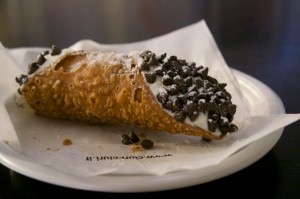 Sicilian cannolo at Ciuri Ciuri. Filled on demand. |
Cannolo Siciliano at Ciuri Ciuri Another non-Roman item, but still worth a try if you are not planning on heading further south to Sicily. A cannolo (or cannoli in the plural) is a crispy deep-fried shell stuffed with something sweet, typically a sweetened ricotta cream. Many places (even in Italy) make the mistake of pre-stuffing the cannoli shells and letting them sit in the display, which, although it might make the service 20 seconds faster, will cause the shell to lose its crispness. Waiting an extra 20 seconds for the shell to be filled in front of you is worth it, so make sure you only buy cannoli from a place that has on display the empty shells, like Ciuri Ciuri in Monti, which produces its own range of Sicilian goods. |
| Saltimbocca alla Romana This typical Roman dish packs together some pretty strong flavours, but done well it can be a taste sensation that jumps around in your mouth, which is exactly where the name saltimbocca comes from. Just about every Roman trattoria serves this dish of thinly sliced veal wrapped in prosciutto and sage and cooked in wine and butter, and it is definitely worth a try at least once. The best saltimbocca I had was at Le Tavernelle trattoria on Via Panisperna in Monti. |
|
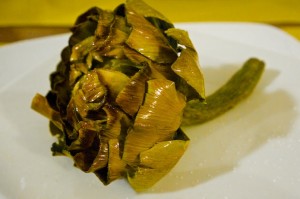 Carciofo alla Giudia at La Carbonara dal 1906 |
Carciofo alla Giudia Perhaps one of the most prominent dishes coming from the Roman-Jewish cuisine is the carciofo alla giudia, or artichoke cooked in a Jewish style. In this case it refers to a whole artichoke that is seasoned and then deep fried, so that the inside is soft and creamy, while the leaves on the outside remain crispy and salty. Artichokes are a bit hard to come by in Australia, but in Rome they are everywhere, so be sure to take the opportunity to try a few. |
Of course this list is incomplete and captures just a fraction of the Roman food offering, but it is certainly a good start for anybody staying in the land of the gladiators for a short time. Whatever you do though, don’t automatically assume that the restaurants lining Piazza Navona or the many other tourist hotspots will be good. In fact, it will likely be quite the opposite, and you will end up with an expensive meal of mediocre quality. For the methodical and planned type, a quick search on the internet (Tripadvisor and blog posts are generally a good start) can provide some great suggestions. However for those who like to wander and select a place to eat, I’d suggest walking through streets that aren’t so jam packed with tourists, like those in Monti and Trastevere. buon appetito!
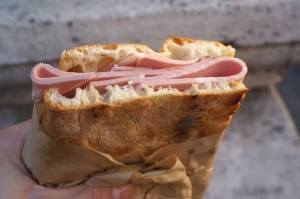
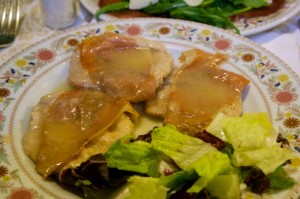
Leave A Comment